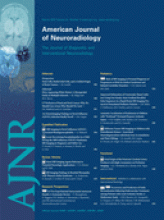Abstract
BACKGROUND AND PURPOSE: Fetal origin of the PCA is a common anatomic variation of the circle of Willis. On perfusion imaging, patients with unilateral fetal-type PCA may demonstrate left-right asymmetry that could mimic cerebrovascular disease. The aim of this study was to characterize the relationship between a fetal-type PCA and asymmetry of hemodynamic parameters derived from MR perfusion imaging.
MATERIALS AND METHODS: We retrospectively reviewed MR perfusion studies of 36 patients to determine the relationship between hemodynamic and vascular asymmetries in the PCA territory. Perfusion asymmetry indices for the PCA territory were computed from maps of rCBF, rCBV, MTT, Tmax, and FMT. Vascular asymmetry indices were derived from calibers of the PCA-P1 segments relative to the posterior communicating arteries.
RESULTS: Asymmetrically smaller values of FMT and Tmax were observed with unilateral fetal-type PCA, and these were strongly correlated with the degree of vascular asymmetry (Spearman's rho = 0.76 and 0.74, respectively, P < 1 × 10−6). Asymmetries of rCBF, MTT, and rCBV were neither significant nor related to vascular asymmetry.
CONCLUSIONS: Faster perfusion transit times are seen for parameters sensitive to macrovascular transit effects (eg, FMT and Tmax) ipsilateral to fetal origin of the PCA in proportion to the degree of arterial asymmetry. Knowledge of this normal variation is critical in the interpretation of perfusion studies because asymmetry could mimic cerebrovascular pathology.
Abbreviations
- AI
- asymmetry index
- AIF
- arterial input function
- ASSET
- array spatial sensitivity encoding technique
- FMT
- first moment of tissue response
- MRA
- MR angiography
- MTT
- mean transit time
- PCA
- posterior cerebral artery
- PcomA
- posterior communicating artery
- rCBF
- relative cerebral blood flow
- rCBV
- relative cerebral blood volume
- ROI
- region of interest
- 3D TOF
- 3D time-of-flight
- Tmax
- time-to-peak of deconvolved residue function
- vAI
- vascular asymmetry index
- Copyright © American Society of Neuroradiology
Indicates open access to non-subscribers at www.ajnr.org












